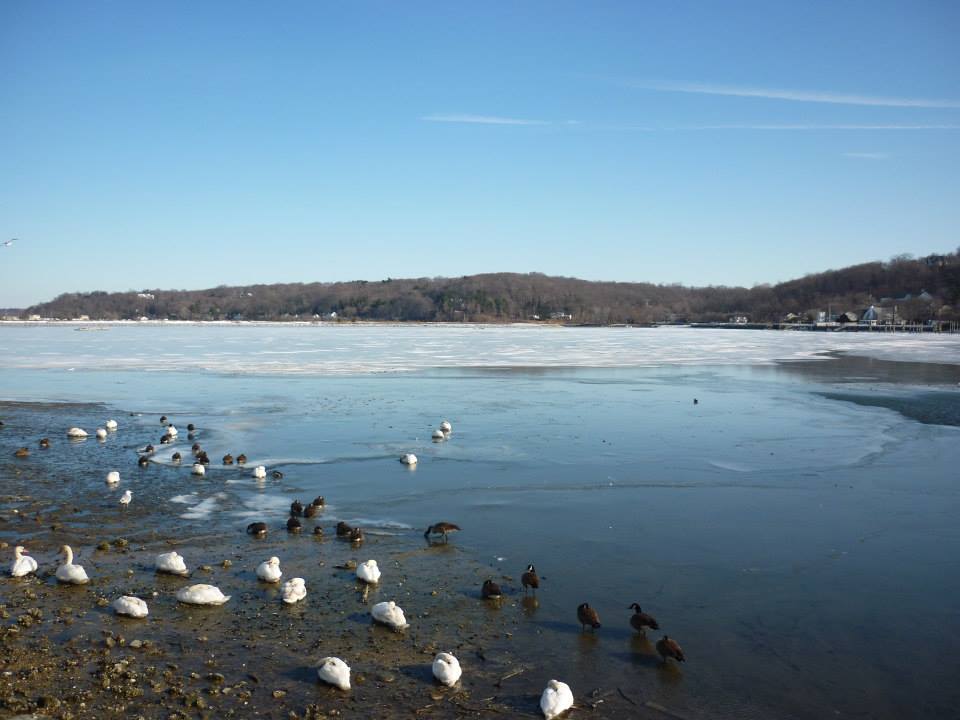From SNPs to starlings: Avian Model Systems 2014, 5th-8th March
Posted by Lucy Freem, on 17 March 2014
Deep snow failed to chill the atmosphere at Cold Spring Harbor Laboratories as the most diverse Avian Model Systems meeting yet took place. The model organisms involved included transgenic quail and zebra finches, canaries, and even barn owls and the American white-throated sparrow, alongside the more prosaic chicken. The interaction of ideas from the endocrine and neurological songbird studies and the more molecular and developmental chicken and quail research was both thought-provoking and useful. As more avian genomes are sequenced, the unifying force of comparative genomics will hopefully make cross-system meetings like this ever more frequent.
Dave Burt from the Roslin Institute opened the meeting on Wednesday evening with a plenary talk on the history of the chicken genome and improvements in the most recently published version, a topic revisited throughout the meeting. Dave discussed some of the features of avian genomes, such as the large numbers of very small microchromosomes, that make sequencing more difficult. The flaws in the published chicken genome were the subject of some discussion, perhaps prompted by the pre-meeting workshop on avian genomics.
The plenary was followed by a session on avian disease models. Of particular interest were several studies in this and later sessions using song learning and vocalisation in songbirds such as zebra finch and canary as models for human speech acquisition and disorders of language.
A major theme that emerged from Thursday morning’s session was the power of fluorescent time lapse imaging combined with germ line fluorescent transgenic birds for documenting developmental events. We were shown spectacular videos of cell migration in fluorescent quail embryos by Rusty Lansford (see below) and membrane GFP chicken gastrulation by Octavian Voiculescu. Samantha Brugmann presented work from her lab on developmental abnormalities in the Talpid2 chicken embryo, a rare natural mutant chicken line.
Feather development was the topic of several talks in Session 3, on avian evolution, and also sprouted up later in Friday’s avian genomics session. The schedule of topics was well-thought out and varied, providing a good mix of topics in any one session and making sure that there was something of relevance to every attendee.
The poster session was lively. Of particular note for developmental biologists was David Huss’s poster on hybridisation chain reaction DNA probes for imaging gene expression in the quail – a potentially very powerful RNA detection system. Joana Esteves de Lima presented an interesting study on BMP and Notch signalling in chick muscle development.
The evening session on bird brains and behaviour on Thursday successfully roused the crowd of jet-lagged scientists. Of special interest for translational researchers was Wan-Chun Liu’s work on a Huntington’s disease model in songbirds using transgenic birds to model the symptoms, including language disorder, of the human disease. The barn owl’s unique sound localisation system and compensatory mechanisms for signal ambiguity in their neural map was covered by Fanny Cazettes. An interesting natural mutation in white-throated sparrows was described by Brent Horton, in a classic study that spanned from observed wild behaviour and ecology to genetic cause. Finally Lauren Riters discussed the various hormonal and neurotransmitter signals that motivate different types of birdsong production in European starlings.
Friday opened with a session on avian genomics. The contentious topic of de-extinction came up, with a speculative talk on passenger pigeon resurrection by Ben Novak that prompted a number of technical objections from the audience. Fiona McCarthy reported on the chicken ENCODE project, which raised a lot of audience interest. There were several speakers who maintain or are creating online databases useful to the avian model research community; a list of useful links is at the end of this article.
The Friday afternoon session covered models for development, with lots of familiar faces for Node readers. Again, the power and flexibility of fluorescent cell tracing tools in the chicken embryo was a strong theme. Tatjana Sauka-Spengler opened with an exploration of the role of enhancers in the cranial neural crest gene regulatory network. Avihu Klar presented some striking imaging experiments using fluorescent labelling and optogenetic constructs in transposons to trace neural circuit development. Daniel Siero-Mosti used fluorescent tracing to look at the organisation of muscle cell fusion events, which create long multinucleated muscle fibres. The final talk before the lobster banquet and bar was given by Claudio Stern, on research done by Angela Torlopp and Mohsin Khan in his lab, discovering genes involved in very early chick embryo axis development.
Despite a late night in the bar and some departures the Saturday morning avian stem cell session went well. Chicken primordial germ cells (PGCs) were the theme of most of the talks. PGCs are the chicken stem cell population under the most widespread investigation, as they have proven applications for developing transgenic chicken models. Mike McGrew presented results on a new and streamlined PGC medium developed in his lab that should allow more widespread use of these cells.
The next meeting in Taiwan in 2016 will hopefully continue the expansion of the Avian Model Systems community.
Useful chicken database links:
http://geisha.arizona.edu/geisha/ Gallus Expression In Situ Hybridisation Analysis
http://geneatlas.arl.arizona.edu/ Chicken ENCODE
www.narf.ed.ac.uk National Avian Research Facility
www.roslin.ed.ac.uk/transgenic-chicken-facility Roslin Institute Transgenic Chicken Facility



 (4 votes)
(4 votes)